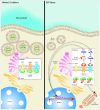Roles and regulation of the mucus barrier in the gut
- PMID: 25838985
- PMCID: PMC4372027
- DOI: 10.4161/21688370.2014.982426
Roles and regulation of the mucus barrier in the gut
Abstract
The gastrointestinal tract is coated by a thick layer of mucus that forms the front line of innate host defense. Mucus consists of high molecular weight glycoproteins called mucins that are synthesized and secreted by goblet cells and functions primarily to lubricate the epithelium and protect it from damage by noxious substances. Recent studies have also suggested the involvement of goblet cells and mucins in complex immune functions such as antigen presentation and tolerance. Under normal physiological conditions, goblet cells continually produce mucins to replenish and maintain the mucus barrier; however, goblet cell function can be disrupted by various factors that can affect the integrity of the mucus barrier. Some of these factors such as microbes, microbial toxins and cytokines can stimulate or inhibit mucin production and secretion, alter the chemical composition of mucins or degrade the mucus layer. This can lead to a compromised mucus barrier and subsequently to various pathological conditions like chronic inflammatory diseases. Insight into how these factors modulate the mucus barrier in the gut is necessary in order to develop strategies to combat these disorders.
Keywords: Barrier function; CD, Crohns disease; ER stress; ERAD, ER-associated protein degradation; EhCP5, Entamoeba histolytica cysteine protease 5; FAS, fatty acid synthase; GI, gastrointestinal; GalNAc, N-Acetylgalactosamine; Goblet cell; IBD; IBD, Inflammatory bowel disease; Innate defense; LLO, Listeriolysin O; LPS, Lipopolysaccharide; MUC2; MucBP, Mucin binding proteins; Mucin; SCFA, short chain fatty acids; Secretory response; UC, Ulcerative colitis; UPR, unfolded protein response; Unfolded protein response.
Figures


References
-
- McCracken VJ, Lorenz RG. The gastrointestinal ecosystem: a precarious alliance among epithelium, immunity and microbiota. Cell Microbiol 2001; 3:1-11; PMID:; http://dx.doi.org/10.1046/j.1462-5822.2001.00090.x - DOI - PubMed
-
- Hollingsworth MA, Swanson BJ. Mucins in cancer: protection and control of the cell surface. Nat Rev Cancer 2004; 4:45-60; PMID:; http://dx.doi.org/10.1038/nrc1251 - DOI - PubMed
-
- Boltin D, Perets TT, Vilkin A, Niv Y. Mucin function in inflammatory bowel disease, an update. J Clin Gastroenterol 2013; 47:106-11; PMID:; http://dx.doi.org/10.1097/MCG.0b013e3182688e73 - DOI - PubMed
-
- Forstner G. Signal transduction, packaging and secretion of mucins. Annu Rev Physiol 1995; 57:585-605; PMID:; http://dx.doi.org/10.1146/annurev.ph.57.030195.003101 - DOI - PubMed
-
- Phillips TE, Phillips TH, Neutra MR. Regulation of intestinal goblet cell secretion. III. Isolated intestinal epithelium. Am J Physiol 1984; 247:G674-G681; PMID: - PubMed
LinkOut - more resources
Full Text Sources
Other Literature Sources
Research Materials
Miscellaneous
